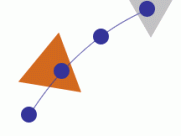Electrical Stimulation Names and Indications
Approximately 9 minutes
There are four common clinical names that describe electrical stimulation devices:
|
Electrical Stimulation Device |
Type of Current |
Summary of Action |
|
Russian |
AC - Burst modulation |
uses current to depolarize muscle and stimulate a muscle contraction |
|
High Volt Pulsed Current (HVPC) |
monophasic, pulsed |
uses high intensity, short duration, pulsed current to promote charge accumulation in the tissue |
|
Interferential Current (IFC) |
amplitude- modulated AC |
asynchronous waves interfere and produce a pain modulating effect; uses four electrodes |
|
Low intensity direct current (LIDC; Microcurrent) |
DC or monophasic pulsed |
uses unidirectional flow of current to accumulate a charge in tissue |
In addition to the common practice of referring to electrical devices when talking about electrical stimulation (ES or "estim), there are three common acronyms that describe types of electrical stimulation:
Electrical Stimulation Acronyms
|
Acronym |
Description |
Effect |
Sample conditions |
|
NMES (motor effect) |
neuromuscular electrical stimulation
|
activation of skeletal muscle for strengthening Measure: manual muscle test or dynamometry |
Post-operative joint repair or replacement Muscle is innervated |
|
FES (motor effect) |
Functional electrical stimulation |
activation of skeletal muscle for reactivation or movement training and recovery of purposeful movement Test or measure: functional task performance |
Post-stroke, spinal cord injury or other paralytic conditions Peripheral nerve innervation is intact |
|
TENS (sensory and circulation effect) |
Transcutaneous nerve stimulation |
applied over skin for pain modulation referred to as "conventional", "sensory" or "high frequency" |
Low back pain; neck pain |
|
TENS (motor and circulation effect) |
Transcutaneous nerve stimulation
|
Twitch motor response applied to affected areas related to the pain referred to as "acupuncture" or "low frequency" |
Generalized pain |
|
HVPC (edema reduction effect) |
High Volt Pulsed Current |
Applied to joints and limbs to reduce acute swelling. The active electrode is the cathode (-) in acute stages |
Acute ligament sprain |
|
HVPC (tissue repair) |
High Volt Pulsed Current |
Applied to wound in the inflammation and proliferation stages; changes in cell membrane and influx of calcium ions promotes tissue healing early stages of healing: cathode (-) is treatment electrode debridement stages (e.g. remodeling): anode (+) is the treatment electrode |
Decubitus ulcers; pressure injury |
Naming can be confusing! To recap, you may hear or read any of the following terms about electrical stimulation applications:
Russian, HVPC, IFC, Microcurrent, NMES, FES, or TENS
In order for therapists to reproduce the effect of electrical stimulation, best practice is to make decisions based on the waveform (e.g., DC, AC, burst or modulated AC, low intensity direct current), pulse frequency, and pulse duration
toc | return to top | previous page | next page


